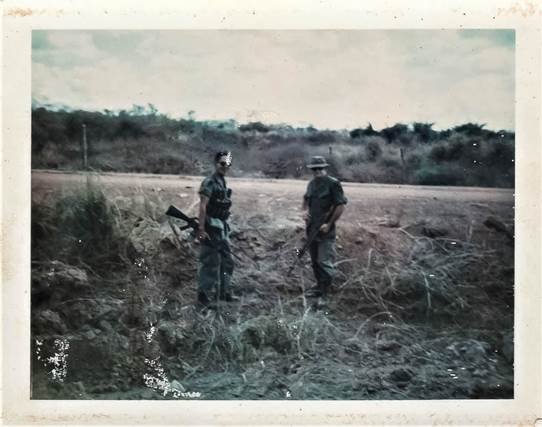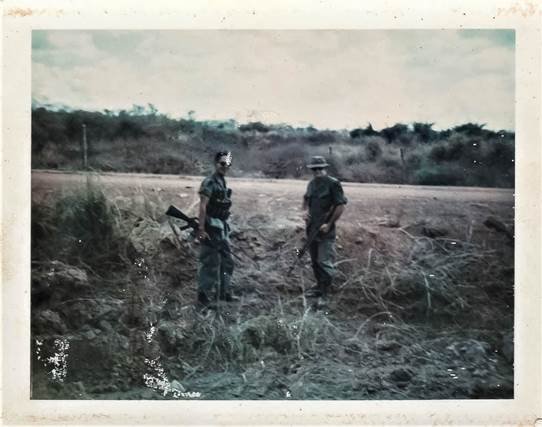
By Charles S., Cripple Creek, Colorado
LZ Mace - 1970 We look pretty nonchalant considering what we'd just been doing. The guy on the left was a warrant-officer (WO) Explosive Ordnance Disposal (EOD) specialist. I'm on the right, the Base Defense Officer (BDO)(call sign Bruiser 10) at LZ Mace, about 50 miles east of Saigon (yeah, I still call it Saigon). I was also in charge of the Base Defense Platoon (BDP) which was a misnomer as it was almost company-sized in the number of assigned personnel.
One of our pilots had spotted an area next to the chopper refueling site, which was outside our perimeter, that looked like it had been disturbed the night before. We brought out the engineers with their mine detectors and they quickly determined that the gooks (yeah, I still call 'em that) had buried an unexploded 500 lb. bomb next to the refueling site. EOD was called out and the BDP provided security.

Contrary to the non-stop action in movies, being at war is about 95% boredom interspersed with moments of excitement, to borrow a phrase. Nothing becomes more easily bored than a 24-year-old junior officer. So I put my platoon sergeant in charge and went over to watch the bomb being disarmed. "Lieutenant, don't say or do anything to distract me or we'll both be vaporized" was the only acknowledgement the WO gave me. Turned out he was lacking some tools but my trusty Buck knife sufficed. About twenty-minutes later the deed was done. The WO was clearly unimpressed withe the gook's circuitry craftmanship and figured that's why the Improvised Explosive Device (IED)(yeah, they were around even back then) hadn't detonated earlier in the morning when the birds were gassing up. After all the effort to disarm it, orders came down to blow it in-place, which we could have done in the beginning. In this photo, the WO is cutting det-cord to rig charges.
Now what in the Hell has any of this to do with guns? If you look closely at the first photo you'll see I was carrying an M-14. Why is this noteworthy? They had been pretty much phased out of active service in the Nam a few years before in favor of the iconic M-16. I found this one in the battalion store-room when I was with the 4th Infantry Division and brought it with me, as it wasn't on the battalion's property list, when I transferred to the 1st Cavalry Division. The 1st Cav sniper school 'accurized' it for me by glass-bedding the stock, increasing the freebore, reworking the trigger group, and some other long-forgotten tricks, virtually turning it into an XM-21 which was the Army's issue sniper rifle.
They gave me a supply of National Match ammo, mounted a 3X9 Redfield scope on it, and sent me on my way. Uh, I almost forgot; they also put a selector switch on it so it could be fired full-auto. Now full-auto, shooting a 7.62mm cartridge in a 10.5 pound rifle, is a handful, but a lot of practice time at the range and I got pretty good at it. (It also didn't hurt that I shot left-handed in those days and this counteracted the rifle's tendency to rise to the right and up when on full auto). We'd also recently been issued the first of the 'small' Starlight (night vision) scopes and, once I had that mounted and sighted in, life became very uncomfortable for any gooks prowling around our perimeter at night. There were no more IED's at Mace while I was there. God! I loved that rifle! One of my regrets in this life, as it wasn't on any property lists (and therefore, as far as the Army was concerned, didn't exist), was that I didn't mail it home in pieces. Those were the days. Bruiser 10, Out!
If you have photos of guns in your family, send them along with some narrative, and we'll be glad to share your heritage with info@teller-rifles.org.